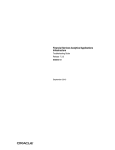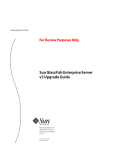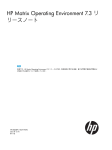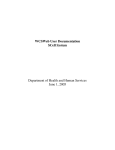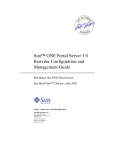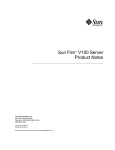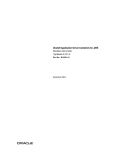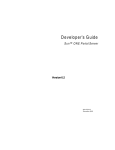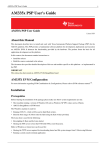Download Sun Microsystems 819468310 Computer Accessories User Manual
Transcript
Sun Java System Access Manager 7.1 Release Notes Sun Microsystems, Inc. 4150 Network Circle Santa Clara, CA 95054 U.S.A. Part No: 819–4683–10 March 2007 Copyright 2007 Sun Microsystems, Inc. 4150 Network Circle, Santa Clara, CA 95054 U.S.A. All rights reserved. Sun Microsystems, Inc. has intellectual property rights relating to technology embodied in the product that is described in this document. In particular, and without limitation, these intellectual property rights may include one or more U.S. patents or pending patent applications in the U.S. and in other countries. U.S. Government Rights – Commercial software. Government users are subject to the Sun Microsystems, Inc. standard license agreement and applicable provisions of the FAR and its supplements. This distribution may include materials developed by third parties. Parts of the product may be derived from Berkeley BSD systems, licensed from the University of California. UNIX is a registered trademark in the U.S. and other countries, exclusively licensed through X/Open Company, Ltd. Sun, Sun Microsystems, the Sun logo, the Solaris logo, the Java Coffee Cup logo, docs.sun.com, Java, and Solaris are trademarks or registered trademarks of Sun Microsystems, Inc. in the U.S. and other countries. All SPARC trademarks are used under license and are trademarks or registered trademarks of SPARC International, Inc. in the U.S. and other countries. Products bearing SPARC trademarks are based upon an architecture developed by Sun Microsystems, Inc. The OPEN LOOK and SunTM Graphical User Interface was developed by Sun Microsystems, Inc. for its users and licensees. Sun acknowledges the pioneering efforts of Xerox in researching and developing the concept of visual or graphical user interfaces for the computer industry. Sun holds a non-exclusive license from Xerox to the Xerox Graphical User Interface, which license also covers Sun's licensees who implement OPEN LOOK GUIs and otherwise comply with Sun's written license agreements. Products covered by and information contained in this publication are controlled by U.S. Export Control laws and may be subject to the export or import laws in other countries. Nuclear, missile, chemical or biological weapons or nuclear maritime end uses or end users, whether direct or indirect, are strictly prohibited. Export or reexport to countries subject to U.S. embargo or to entities identified on U.S. export exclusion lists, including, but not limited to, the denied persons and specially designated nationals lists is strictly prohibited. DOCUMENTATION IS PROVIDED “AS IS” AND ALL EXPRESS OR IMPLIED CONDITIONS, REPRESENTATIONS AND WARRANTIES, INCLUDING ANY IMPLIED WARRANTY OF MERCHANTABILITY, FITNESS FOR A PARTICULAR PURPOSE OR NON-INFRINGEMENT, ARE DISCLAIMED, EXCEPT TO THE EXTENT THAT SUCH DISCLAIMERS ARE HELD TO BE LEGALLY INVALID. Copyright 2007 Sun Microsystems, Inc. 4150 Network Circle, Santa Clara, CA 95054 U.S.A. Tous droits réservés. Sun Microsystems, Inc. détient les droits de propriété intellectuelle relatifs à la technologie incorporée dans le produit qui est décrit dans ce document. En particulier, et ce sans limitation, ces droits de propriété intellectuelle peuvent inclure un ou plusieurs brevets américains ou des applications de brevet en attente aux Etats-Unis et dans d'autres pays. Cette distribution peut comprendre des composants développés par des tierces personnes. Certaines composants de ce produit peuvent être dérivées du logiciel Berkeley BSD, licenciés par l'Université de Californie. UNIX est une marque déposée aux Etats-Unis et dans d'autres pays; elle est licenciée exclusivement par X/Open Company, Ltd. Sun, Sun Microsystems, le logo Sun, le logo Solaris, le logo Java Coffee Cup, docs.sun.com, Java et Solaris sont des marques de fabrique ou des marques déposées de Sun Microsystems, Inc. aux Etats-Unis et dans d'autres pays. Toutes les marques SPARC sont utilisées sous licence et sont des marques de fabrique ou des marques déposées de SPARC International, Inc. aux Etats-Unis et dans d'autres pays. Les produits portant les marques SPARC sont basés sur une architecture développée par Sun Microsystems, Inc. L'interface d'utilisation graphique OPEN LOOK et Sun a été développée par Sun Microsystems, Inc. pour ses utilisateurs et licenciés. Sun reconnaît les efforts de pionniers de Xerox pour la recherche et le développement du concept des interfaces d'utilisation visuelle ou graphique pour l'industrie de l'informatique. Sun détient une licence non exclusive de Xerox sur l'interface d'utilisation graphique Xerox, cette licence couvrant également les licenciés de Sun qui mettent en place l'interface d'utilisation graphique OPEN LOOK et qui, en outre, se conforment aux licences écrites de Sun. Les produits qui font l'objet de cette publication et les informations qu'il contient sont régis par la legislation américaine en matière de contrôle des exportations et peuvent être soumis au droit d'autres pays dans le domaine des exportations et importations. Les utilisations finales, ou utilisateurs finaux, pour des armes nucléaires, des missiles, des armes chimiques ou biologiques ou pour le nucléaire maritime, directement ou indirectement, sont strictement interdites. Les exportations ou réexportations vers des pays sous embargo des Etats-Unis, ou vers des entités figurant sur les listes d'exclusion d'exportation américaines, y compris, mais de manière non exclusive, la liste de personnes qui font objet d'un ordre de ne pas participer, d'une façon directe ou indirecte, aux exportations des produits ou des services qui sont régis par la legislation américaine en matière de contrôle des exportations et la liste de ressortissants spécifiquement designés, sont rigoureusement interdites. LA DOCUMENTATION EST FOURNIE "EN L'ETAT" ET TOUTES AUTRES CONDITIONS, DECLARATIONS ET GARANTIES EXPRESSES OU TACITES SONT FORMELLEMENT EXCLUES, DANS LA MESURE AUTORISEE PAR LA LOI APPLICABLE, Y COMPRIS NOTAMMENT TOUTE GARANTIE IMPLICITE RELATIVE A LA QUALITE MARCHANDE, A L'APTITUDE A UNE UTILISATION PARTICULIERE OU A L'ABSENCE DE CONTREFACON. 070301@16599 Contents Sun Java System Access Manager 7.1 Release Notes .......................................................................5 Revision History .....................................................................................................................................6 About Sun Java System Access Manager 7.1 ........................................................................................6 What’s New in This Release ...................................................................................................................6 Java ES Monitoring Framework Integration ...............................................................................6 Web Service Security ......................................................................................................................7 Single Access Manager WAR file deployment .............................................................................7 Enhancements to Core Services ....................................................................................................7 Deprecation Notification and Announcement ........................................................................ 10 Hardware and Software Requirements ............................................................................................. 10 Supported Browsers ..................................................................................................................... 12 General Compatibility Information .................................................................................................. 13 AMSDK intersystem incompatibility with Access Manager server ....................................... 13 Upgrade not supported for Access Manager HPUX version .................................................. 13 Access Manager Legacy Mode .................................................................................................... 14 Access Manager Policy Agents ................................................................................................... 15 Known Issues and Limitations ........................................................................................................... 16 Installation Issues ......................................................................................................................... 16 Upgrade Issues ............................................................................................................................. 16 Compatibility Issues .................................................................................................................... 16 Configuration Issues .................................................................................................................... 19 Access Manager Console Issues ................................................................................................. 21 Command Line Issue ................................................................................................................... 22 SDK and Client Issues .................................................................................................................. 23 Authentication Issues .................................................................................................................. 23 Session and SSO Issues ................................................................................................................ 25 Policy Issues .................................................................................................................................. 26 Server Startup Issues .................................................................................................................... 26 3 Contents AMSDK Issues .............................................................................................................................. 27 SSL Issue ........................................................................................................................................ 28 Samples Issue ................................................................................................................................ 29 Linux OS Issues ............................................................................................................................ 29 Windows and HP-UX Issues ...................................................................................................... 30 Federation and SAML Issues ...................................................................................................... 30 Globalization (g11n) Issues ........................................................................................................ 31 Documentation Issues ................................................................................................................. 33 Documentation Updates .................................................................................................................... 34 Redistributable Files ............................................................................................................................ 34 How to Report Problems and Provide Feedback ............................................................................. 35 Sun Welcomes Your Comments ................................................................................................ 35 Additional Sun Resources .................................................................................................................. 35 Accessibility Features for People With Disabilities .................................................................. 36 Related Third-Party Web Sites .......................................................................................................... 36 4 Sun Java System Access Manager 7.1 Release Notes • March 2007 Sun Java System Access Manager 7.1 Release Notes March 2007 Part Number 819-4683-10 The Sun JavaTM System Access Manager 7.1 Release Notes contain important information available for the Sun Java Enterprise System (Java ES) release, including new Access Manager features and known issues with workarounds, if available. Read this document before you install and use this release. To view the Java ES product documentation, including the Access Manager collection, see http://docs.sun.com/prod/entsys.05q4. Check this site prior to installing and setting up your software and then periodically thereafter to view the most up-to-date documentation. These Release Notes Contain the following sections: ■ ■ ■ ■ ■ ■ ■ ■ ■ ■ ■ “Revision History” on page 6 “About Sun Java System Access Manager 7.1” on page 6 “What’s New in This Release” on page 6 “Hardware and Software Requirements” on page 10 “General Compatibility Information” on page 13 “Known Issues and Limitations” on page 16 “Documentation Updates” on page 34 “Redistributable Files” on page 34 “How to Report Problems and Provide Feedback” on page 35 “Additional Sun Resources” on page 35 “Related Third-Party Web Sites” on page 36 5 Revision History Revision History The following table shows the Access Manager 7.1 Release Notes revision history. TABLE 1 Revision History Date Description of Changes July 2006 Beta release. March 2007 Java Enterprise System 5 release About Sun Java System Access Manager 7.1 Sun Java System Access Manager is part of the Sun Identity Management infrastructure that allows an organization to manage secure access to Web applications and other resources both within an enterprise and across business-to-business (B2B) value chains. Access Manager provides these main functions: ■ Centralized authentication and authorization services using both role-based and rule-based access control ■ Single sign-on (SSO) for access to an organization's Web-based applications ■ Federated identity support with the Liberty Alliance Project and Security Assertions Markup Language (SAML) ■ Logging of critical information including administrator and user activities by Access Manager components for subsequent analysis, reporting, and auditing. What’s New in This Release This release includes the following new features: ■ ■ ■ ■ ■ “Java ES Monitoring Framework Integration” on page 6 “Web Service Security ” on page 7 “Single Access Manager WAR file deployment” on page 7 “Enhancements to Core Services” on page 7 “Deprecation Notification and Announcement” on page 10 Java ES Monitoring Framework Integration Access Manager 7.1 integrates with the Java Enterprise System monitoring framework through Java Management Extensions (JMX). JMX technology provides the tools for building distributed, Web-based, modular, and dynamic solutions for managing and monitoring 6 Sun Java System Access Manager 7.1 Release Notes • March 2007 What’s New in This Release devices, applications, and service-driven networks. Typical uses of the JMX technology include: consulting and changing application configuration, accumulating statistics about application behavior, notification of state changes and erroneous behaviors. Data is delivered to centralized monitoring console. Access Manager 7.1 uses the Java ES Monitoring Framework to capture statistics and service-related data such as the following: ■ ■ ■ Number of attempted, successful, and failed authentications Policy caching statistics Policy evaluation transaction times Web Service Security Access Manager 7.1 extends authentication capabilities to web services in the following ways: ■ Inserts tokens to outgoing messages ■ Evaluates incoming messages for security tokens ■ Enables point-and-click selection of Authentication providers for new applications Single Access Manager WAR file deployment Access Manager includes a single WAR file you can use to deploy Access Manager services consistently to any supported container on any supported platform. The Access Manager WAR file coexists with the Java Enterprise System installer which deploys multiple JAR, XML, JSP, HTML, GIF, and various properties files. Enhancements to Core Services Web Containers supported ■ ■ ■ ■ Sun Java System Web Server 7.0 Sun Java System Application Server 8.2 BEA WL 8.1 SP4 IBM WebSphere 5.1.1.6 Monitoring Framework Integration Access Manager can use the JES Monitoring Framework to monitor the following: 1. Authentication ■ ■ Number of authentications attempted Number of remote authentications attempted (optional) Sun Java System Access Manager 7.1 Release Notes 7 What’s New in This Release ■ ■ ■ ■ ■ Number of successful authentications Number of failed authentications Number of successful logout operations Number of failed logout operations Transaction time for each module if possible (running and waiting states) 2. Sessions ■ ■ Size of the session table (hence maximum number of sessions) Number of active sessions (incremental counter) 3. Profile Service ■ ■ Maximum cache size Transaction time for operations (running and waiting) 4. Policy ■ ■ Policy evaluation in and out requests Policy connection pool statistics for the subject's plug-in's LDAP server Authentication module ■ Distributed Authentication service not required to stick to one server for load-balanced deployments ■ Authentication service and server not required to stick to one server for load—balanced deployments ■ Composite advices support among Authentication service, Policy Agents, and Policy service. Includes AuthenticateToRealm condition, AuthenticateToService condition, and realm qualification to all conditions. ■ Advising organization (realm qualified Authentication conditions) ■ Authentication configurations / authentication chains (AuthServiceCondition) ■ Module-based authentication can now be disallowed if Authentication chaining is enforced ■ Distributed Authentication service supports Certificate authentication module ■ Added CertAuth to Distributed Authentication UI to make it a full featured credential extractor presentation ■ New Datastore authentication module as an out-of-box module which authenticates against the configured datastore for a given realm ■ Account lockout configuration now persistent across multiple AM server instances ■ Chaining of post-processing SPI classes Policy module ■ 8 A new policy condition AuthenticateToServiceCondition added, to enforce the user is authenticated to specifc authentication service chain. Sun Java System Access Manager 7.1 Release Notes • March 2007 What’s New in This Release ■ A new policy condition AuthenticateToRealmCondition added, to enforce the user is authenticated to a specific realm. ■ A new policy condition LDAPFilterCondition is added, to enforce the user matches the specified ldap filter. ■ Support for one level wild card compare to facilitate protecting the contents of the directory without protecting sub-directory. ■ Policies can be created in subrealms without explicit referral policies from parent realm if organization alias referral is enabled in global policy configuration. ■ AuthLevelCondition can specify the realm name in addition to authentication level. ■ AuthSchemeCondition can specify the realm name in addition to authentication module name . Service Management module ■ Support for storing Service Management/Policy configuration in Active Directory Access Manager SDK ■ Support APIs for authenticating users to a default Identity Repository framework database Web Services support ■ Liberty ID-WSF SOAP provider: Authentication provider that encapsulates the Liberty ID-WSF SOAP binding as implemented by Access Manager. This consists of a client and service provider. ■ HTTP layer SSO provider: HttpServlet layer authentication provider that encapsulates server-side Access Manager-based SSO Installation module ■ Repackaging Access Manager as J2EE Application resulting in a single WAR file to become web deployable ■ Support for 64-bit SJS Web Server 7.0 - to support the 64-bit JVM Delegation module ■ Support for grouping of delegation privileges Upgrade ■ Supports upgrade to Access Manager 7.1 from the following versions: Access Manager 7.0 2005Q4, Access Manager 6.3 2005Q1, and Identity Server 6.2 2004Q2. Logging ■ Support for delegation in logging module - controlling which Identities are authorized to write to or read from the log files. Sun Java System Access Manager 7.1 Release Notes 9 Hardware and Software Requirements ■ Support JCE Based SecureLogHelper - making it possible to use JCE (in addition to JSS) as a security provider for Secure Logging implementation Deprecation Notification and Announcement Sun Java(TM) System Access Manager 7.1 identity management APIs and XML templates enable system administrators to create, delete, and manage identity entries in Sun Java System Directory Server. Access Manager also provides APIs for identity management. Developers use the public interfaces and classes defined in the com.iplanet.am.sdk package to integrate management functions into external applications or services to be managed by Access Manager. Access Manager APIs provide the means to create or delete identity-related objects as well as to get, modify, add, or delete the objects' attributes from Directory Server. The Access Manager com.iplanet.am.sdk package, commonly known as AMSDK, will not be included in a future Access Manager release. This includes all related APIs and XML templates. No migration options are available now, and no migration options are expected to be available in the future. The user provisioning solutions provided by Sun Java System Identity Manager are compatible replacements that you can start to use now. For more information about Sun Java System Identity Manager, see http://www.sun.com/software/products/identity_mgr/index.xml. Hardware and Software Requirements The following table shows the hardware and software that are required for this release. 10 Sun Java System Access Manager 7.1 Release Notes • March 2007 Hardware and Software Requirements TABLE 2 Hardware and Software Requirements Component Requirement Operating system (OS) ■ SolarisTM10 on SPARC, x86, and x64 based systems, including support for whole root local and sparse root zones. ■ Solaris 9 on SPARC and x86 based systems. Red HatTM Enterprise Linux 3 and 4, all updates Advanced Server (32 and 64–bit versions) and Enterprise Server (32 and 64–bit versions) ■ ■ Windows Windows 2000 Advanced Server, Data Center Server version SP4 on x86 Windows 2003 Standard (32 and 64–bit versions), Enterprise (32 and 64–bit versions), Data Center Server (32–bit version) on x86 and x64 based systems Windows XP Professional SP2 on x86 based systems HP-UX 11i v1 (11.11 from uname), 64–bit on PA-RISC 2.0 For the most updated list of supported operating systems, see “Platform Requirements and Issues” in Sun Java Enterprise System 5 Release Notes for UNIX in the Sun Java Enterprise System 5 Release Notes for UNIX, or “Hardware and Software Platform Information” in Sun Java Enterprise System 5 Release Notes for Microsoft Windows in the Sun Java Enterprise System 5 Release Notes for Windows. Java 2 Standard Edition (J2SE) J2SE platform 6.0, 5.0 Update 9 (HP-UX: 1.5.0.03), and 1.4.2 Update 11 Directory Server Access Manager information tree: Sun Java System Directory Server 6.0 or Sun Java System Directory Server 5.2 2005Q4 Access Manager identity repository: Sun Java System Directory Server 6.0 or Microsoft Active Directory Sun Java System Access Manager 7.1 Release Notes 11 Hardware and Software Requirements TABLE 2 Hardware and Software Requirements (Continued) Component Requirement Web containers Sun Java System Web Server 7.0 On supported platform/OS combinations you may elect to run the Web Server instance in a 64 bit JVM. Support platforms: Solaris 9/SPARC, Solaris 10/SPARC, Solaris 10/AMD64, Red Hat AS or ES 3.0/AMD64, Red Hat AS or ES 4.0/AMD64 Sun Java System Application Server Enterprise Edition 8.2 BEA WebLogic 8.1 SP4 IBM WebSphere Application Server 5.1.1.6 RAM Basic testing: 512 Mbytes Actual deployment: 1 Gbyte for threads, Access Manager SDK, HTTP server, and other internals Disk space 512 Mbytes for Access Manager and associated applications If you have questions about support for other versions of these components, contact your Sun Microsystems technical representative. Supported Browsers The following table shows the browsers that are supported by the Sun Java Enterprise System 5 release. TABLE 3 Supported Browsers Browser Platform Firefox 1.0.7 Windows XP Windows 2000 Solaris OS, versions 9 and 10 Red Hat Linux 3 and 4 Mac OS X 12 Microsoft Internet ExplorerTM 6.0 SP2 Windows XP Microsoft Internet Explorer 6.0 SP1 WindowsTM 2000 Sun Java System Access Manager 7.1 Release Notes • March 2007 General Compatibility Information TABLE 3 Supported Browsers (Continued) Browser Platform MozillaTM 1.7.12 Solaris OS, versions 9 and 10 Windows XP Windows 2000 Red Hat Linux 3 and 4 Mac OS X Netscape TM Communicator 8.0.4 Windows XP Windows 2000 Netscape Communicator 7.1 Solaris OS, versions 9 and 10 General Compatibility Information ■ ■ ■ ■ “AMSDK intersystem incompatibility with Access Manager server” on page 13 “Upgrade not supported for Access Manager HPUX version” on page 13 “Access Manager Legacy Mode” on page 14 “Access Manager Policy Agents” on page 15 AMSDK intersystem incompatibility with Access Manager server The following combinations are not compatible between the AMSDK and the Access Manager server in the following Java Enterprise System releases: ■ Java Enterprise System 2004Q2 AMSDK is not compatible with the Java Enterprise System 5 Access Manager server (this release). ■ Java Enterprise System 5 AMSDK (this release) is not compatible with the Java Enterprise System Access Manger 2004Q2 (formerly Identity Server) server. Upgrade not supported for Access Manager HPUX version There is no support for an upgrade path from Access Manager 7 2005Q4 to Access Manger 7.1 (this release) for the HPUX version. Sun Java System Access Manager 7.1 Release Notes 13 General Compatibility Information Access Manager Legacy Mode If you are installing Access Manager with any of the following products, you must select the Access Manager Legacy (6.x) mode: ■ Sun Java System Portal Server ■ Sun Java System Communications Services servers, including Messaging Server, Calendar Server, Instant Messaging, or Delegated Administrator You select the Access Manager Legacy (6.x) mode, depending on how you are running the Java ES installer: ■ ■ ■ ■ “Java ES Silent Installation Using a State File” on page 14 ““Configure Now” Installation Option in Graphical Mode” on page 14 ““Configure Now” Installation Option in Text-Based Mode” on page 14 ““Configure Later” Installation Option” on page 15 To determine the more for an Access Manager 7.1 installation, see “Determining the Access Manager Mode” on page 15. Java ES Silent Installation Using a State File Java ES installer silent installation is a non-interactive mode that allows you to install Java ES components on multiple host servers that have similar configurations. You first run the installer to generate a state file (without actually installing any components) and then edit a copy of the state file for each host server where you plan to install Access Manager and other components. To select Access Manager in Legacy (6.x) mode, set the following parameter (along with other parameters) in the state file before you run the installer in silent mode: ... AM_REALM = disabled ... For more information about running the Java ES installer in silent mode using a state file, see the Chapter 5, “Installing in Silent Mode,” in Sun Java Enterprise System 5 Installation Guide for UNIX. “Configure Now”Installation Option in Graphical Mode If you are running the Java ES Installer in graphical mode with the “Configure Now” option, on the “Access Manager: Administration (1 of 6)” panel, select “Legacy (version 6.x style)”, which is the default value. “Configure Now”Installation Option in Text-Based Mode If you are running the Java ES Installer in text-based mode with the “Configure Now” option, for Install type (Realm/Legacy) [Legacy] select Legacy, which is the default value. 14 Sun Java System Access Manager 7.1 Release Notes • March 2007 General Compatibility Information “Configure Later”Installation Option If you ran the Java ES Installer with the “Configure Later“ option, you must run the amconfig script to configure Access Manager after installation. To select Legacy (6.x) mode, set the following parameter in your configuration script input file (amsamplesilent): ... AM_REALM=disabled ... For more information about configuring Access Manager by running the amconfig script, refer to the Sun Java System Access Manager 7.1 Administration Guide. Determining the Access Manager Mode To determine whether a running Access Manager 7.1 installation has been configured in Realm or Legacy mode, invoke: http(s)://host:port/amserver/SMSServlet?method=isRealmEnabled Results are: ■ ■ true: Realm mode false: Legacy mode Access Manager Policy Agents The following table shows the compatibility of Policy Agents with the Access Manager 7.1 modes. TABLE 4 Policy Agents Compatibility With Access Manager 7.1 Modes Agent and Version Compatible Mode Web and J2EE agents, version 2.2 Legacy and Realm modes Web and J2EE agents, version 2.1 are not supported in Access Manager 7.1 Sun Java System Access Manager 7.1 Release Notes 15 Known Issues and Limitations Known Issues and Limitations This section describes the following known issues and workarounds, if available, at the time of the Access Manager 7.1 release. ■ ■ ■ ■ ■ ■ ■ ■ ■ ■ ■ ■ ■ ■ ■ ■ ■ ■ ■ “Installation Issues” on page 16 “Upgrade Issues” on page 16 “Compatibility Issues” on page 16 “Configuration Issues” on page 19 “Access Manager Console Issues” on page 21 “Command Line Issue” on page 22 “SDK and Client Issues” on page 23 “Authentication Issues” on page 23 “Session and SSO Issues” on page 25 “Policy Issues” on page 26 “Server Startup Issues” on page 26 “AMSDK Issues” on page 27 “SSL Issue” on page 28 “Samples Issue” on page 29 “Linux OS Issues” on page 29 “Windows and HP-UX Issues” on page 30 “Federation and SAML Issues” on page 30 “Globalization (g11n) Issues” on page 31 “Documentation Issues” on page 33 Installation Issues Information about installation issues is contained in the JES5 Release Notes. See the section “Access Manager Installation Issues” in Sun Java Enterprise System 5 Release Notes for UNIX. Upgrade Issues Information about upgrade issues is contained in section “Upgrade Issues” in Sun Java Enterprise System 5 Release Notes for UNIX in the Sun Java Enterprise System 5 Release Notes for UNIX. Compatibility Issues ■ ■ 16 “Access Manager Single Sign-On fails on Universal Web Client (6367058, 6429573)” on page 17 “StackOverflowError occurs on Web Server 7.0 running in 64–bit mode (6449977)” on page 17 Sun Java System Access Manager 7.1 Release Notes • March 2007 Known Issues and Limitations ■ ■ ■ “Incompatibilities exist in core authentication module for legacy mode (6305840)” on page 18 “Delegated Administrator commadmin utility does not create a user (6294603)” on page 18 “Delegated Administrator commadmin utility does not create an organization (6292104)” on page 18 Access Manager Single Sign-On fails on Universal Web Client (6367058, 6429573) The problem occurs after you install Access Manager, Messaging Server, and Calendar Server and configure them to work together, and then install the JES5 120955-01 patch. The user encounters a login error. The error is due to an incompatibility between Policy Agent 2.1 properties and AMSDK. There is no workaround at this time. This problem will be fixed in the final Access Manager 7.1 release. StackOverflowError occurs on Web Server 7.0 running in 64–bit mode (6449977) If Access Manager is configured on a Web Server 7.0 instance using a 64–bit JVM, the user encounters a Server Error message when accessing the console login page. The Web Server error log contains a StackOverflowError exception. Workaround: Modify the Web Server configuration by following these steps: 1. Log in to the Web Server administration console as the Web Server administrator. 2. Click Edit Configuration. In the Platform field, select 64, then click Save. 3. Click the Java tab, and then click the JVM Settings tab. ■ Under Options, look for the minimum heap size entry (for example : -Xms). The minimum heap size value should be at least 512m. For example, if the heap size value is not -Xms512m or greater, then change the value to at least -Xms512m. ■ The maximum heap size value should be at least 768m. If the maximum heap size is not -Xmx768m or greater, then change the value to at least -Xmx768m. ■ Set the Java stack size to 512k or 768k by using -Xss512k or -Xss768k. You can leave it at the default size for 64-bit JVM on Solaris Sparc (1024k) by leaving it blank. 4. Click the Performance tab, then click the link "Thread Pool Settings.” Change the stack size value to at least 261144, and then click Save. 5. Click the "Deployment Pending" link in the upper right corner of the screen. In the Configuration Deployment page, click the Deploy button. 6. In the Results window, click OK to restart the Web Server instance. Click the Close in the Results window after the Web Server has been restarted. Sun Java System Access Manager 7.1 Release Notes 17 Known Issues and Limitations Incompatibilities exist in core authentication module for legacy mode (6305840) Access Manager 7.1 legacy mode has the following incompatibilities in the core authentication module from Access Manager 6 2005Q1: ■ Organization Authentication Modules are removed in legacy mode. ■ The presentation of the “Administrator Authentication Configuration” and “Organization Authentication Configuration” has changed. In the Access Manager 7.1 Console, the drop-down list has ldapService selected by default. In the Access Manager 6 2005Q1 Console, the Edit button was provided, and the LDAP module was not selected by default. Workaround: None. Delegated Administrator commadmin utility does not create a user (6294603) The Delegated Administrator commadmin utility with the -S mail,cal option does not create a user in the default domain. Workaround: This problem occurs if you upgrade Access Manager to version 7.1 but you do not upgrade Delegated Administrator. If you do not plan to upgrade Delegated Administrator, follow these steps: 1. In the UserCalendarService.xml file, mark the mail, icssubcribed, and icsfirstday attributes as optional instead of required. This file is located by default in the /opt/SUNWcomm/lib/services/ directory on Solaris systems. 2. In Access Manager, remove the existing XML file by running the amadmin command, as follows: # ./amadmin -u amadmin -w password -r UserCalendarService 3. In Access Manager, add the updated XML file, as follows: # ./amadmin -u amadmin -w password -s /opt/SUNWcomm/lib/services/UserCalendarService.xml 4. Restart the Access Manager web container. Delegated Administrator commadmin utility does not create an organization (6292104) The Delegated Administrator commadmin utility with the -S mail,cal option does not create an organization. Workaround: See the workaround for the previous problem. 18 Sun Java System Access Manager 7.1 Release Notes • March 2007 Known Issues and Limitations Configuration Issues ■ ■ ■ ■ ■ ■ ■ “Notification URL needs to be updated for Access Manager SDK installation without web container (6491977)” on page 19 “Password Reset service reports notification errors when a password is changed (6455079)” on page 19 “Platform server list and FQDN alias attribute are not updated (6309259, 6308649)” on page 20 “Data validation for required attributes in the services (6308653)” on page 20 “Document workaround for deployment on a secure WebLogic 8.1 instance (6295863)” on page 20 “The amconfig script does not update the realm/DNS aliases and platform server list entries (6284161)” on page 20 “Default Access Manager mode is realm in the configuration state file template (6280844)” on page 21 Notification URL needs to be updated for Access Manager SDK installation without web container (6491977) If you install the Access Manager SDK without a web container by running the Java ES 5 installer with the Configure Now option, the com.iplanet.am.notification.url property in the AMConfig.properties file is set to NOTIFICATION_URL. If you don't perform any additional web container configuration, users will not receive notifications from the remote Access Manager server. Workaround: Reset this property as follows: com.iplanet.am.notification.url="" Password Reset service reports notification errors when a password is changed (6455079) When a password is changed, Access Manager submits the email notification using an unqualified sender name Identity-Server which results in errors entries in the amPasswordReset logs. Example: 07/19/2006 10:26:04:010 AM PDT: Thread[service-j2ee,5,main] ERROR: Could not send email to user [Ljava.lang.String;@999262 com.sun.mail.smtp.SMTPSendFailedException: 553 5.5.4 <Identity-Server>... Domain name required for sender address Identity-Server Workaround: Change the configuration in /opt/SUNWam/locale/amPasswordResetModuleMsgs.properties. ■ Change the from address. Change fromAddress.label=<Identity-Server> to fromAddress.label=<[email protected]> ■ Change the lockOutEmailFrom property to insure that lockout notifications use the correct from address. Sun Java System Access Manager 7.1 Release Notes 19 Known Issues and Limitations Platform server list and FQDN alias attribute are not updated (6309259, 6308649) In a multiple server deployment, the platform server list and FQDN alias attribute are not updated if you install Access Manager on the second (and subsequent) servers. Workaround: Add the Realm/DNS aliases and platform server list entries manually. For the steps, see the section “Adding Additional Instances to the Platform Server List and Realm/DNS Aliases” in Sun Java System Access Manager 7.1 Postinstallation Guide. Data validation for required attributes in the services (6308653) Access Manager 7.1 enforces required attributes in service XML files to have default values. Workaround: If you have services with required attributes that do not have values, add values for the attributes and then reload the service. Document workaround for deployment on a secure WebLogic 8.1 instance (6295863) If you deploy Access Manager 7.1 into a secure (SSL enabled) BEA WebLogic 8.1 SP4 instance, an exception occurs during the deployment of each Access Manager web application. Workaround: Follow these steps: 1. Apply the WebLogic 8.1 SP4 patch JAR CR210310_81sp4.jar, which is available from BEA. 2. In the /opt/SUNWam/bin/amwl81config script, (Solaris systems) or /opt/sun/identity/bin/amwl81config script (Linux systems), update the doDeploy function and the undeploy_it function to prepend the path of the patch JAR to the wl8_classpath, which is the variable that contains the classpath used to deploy and un-deploy the Access Manager web applications. Find the following line containing the wl8_classpath: wl8_classpath= ... 3. Immediately after the line you found in Step 2, add the following line: wl8_classpath=path-to-CR210310_81sp4.jar:$wl8_classpath The amconfig script does not update the realm/DNS aliases and platform server list entries (6284161) In a multiple server deployment, the amconfig script does not update the realm/DNS aliases and platform server list entries for additional Access Manager instances. Workaround: Add the Realm/DNS aliases and platform server list entries manually. For the steps, see the section “Adding Additional Instances to the Platform Server List and Realm/DNS Aliases” in Sun Java System Access Manager 7.1 Postinstallation Guide. 20 Sun Java System Access Manager 7.1 Release Notes • March 2007 Known Issues and Limitations Default Access Manager mode is realm in the configuration state file template (6280844) By default, the Access Manager mode (AM_REALM variable) is enabled in the configuration state file template. Workaround: To install or configure Access Manager in Legacy mode, reset the variable in the state file: AM_REALM = disabled Access Manager Console Issues ■ ■ ■ ■ “New Access Manager Console cannot set the CoS template priorities (6309262)” on page 21 “Old console appears when adding Portal Server related services (6293299)” on page 21 “Console does not return the results set from Directory Server after reaching the resource limit (6239724)” on page 22 “Add ContainerDefaultTemplateRole attribute after data migration (4677779)” on page 22 New Access Manager Console cannot set the CoS template priorities (6309262) The new Access Manager 7.1 Console cannot set or modify a Class of Service (CoS) template priority. Workaround: Login to the Access Manager 6 2005Q1 Console to set or modify a CoS template priority. Old console appears when adding Portal Server related services (6293299) Portal Server and Access Manager are installed on the same server. With Access Manager installed in Legacy mode, login to the new Access Manager Console using /amserver. If you choose an existing user and try to add services (such as NetFile or Netlet), the old Access Manager Console (/amconsle) suddenly appears. Workaround: None. The current version of Portal Server requires the Access Manager 6 2005Q1 Console. Sun Java System Access Manager 7.1 Release Notes 21 Known Issues and Limitations Console does not return the results set from Directory Server after reaching the resource limit (6239724) Install Directory Server and then Access Manager with the existing DIT option. Login to the Access Manager Console and create a group. Edit the users in the group. For example, add users with the filter uid=*999*. The resulting list box is empty, and the console does not display any error, information, or warning messages. Workaround: The group membership must not be greater than the Directory Server search size limit. If the group membership is greater, change the search size limit accordingly. Add ContainerDefaultTemplateRole attribute after data migration (4677779) In Legacy mode, he user's role does not display under an organization that was not created in Access Manager. In debug mode, the following message is displayed: ERROR: DesktopServlet.handleException() com.iplanet.portalserver.desktop.DesktopException: DesktopServlet.doGetPost(): no privilige to execute desktop This error becomes evident after the Java ES installer migration scripts are run. The ContainerDefaultTemplateRole attribute is not automatically added to the organization when the organization is migrated from an existing directory information tree (DIT) or from another source. Workaround:Use the Directory Server console to copy the ContainerDefaultTemplateRole attribute from another Access Manager organization and then add it to the affected organization. Command Line Issue Organization Admin role is fails to create a new user with the amadmin command line utility (6480776) An administrator assigned the Organization Admin role is not able to create a new user with the amadmin command line utility due to incorrect logging privileges. Workaround: Both the Organization Admin and the Top-level admin may set the permissions. To do so through the Administration Console: 1. 2. 3. 4. 22 Go to the organization to which the Organization Admin belongs. Click on the Privileges tab. Click on the Organization Admin Role link. Select Read and write access to all log files or Write access to all log files. Sun Java System Access Manager 7.1 Release Notes • March 2007 Known Issues and Limitations 5. Click Save. SDK and Client Issues ■ ■ “Clients do not get notifications after the server restarts (6309161)” on page 23 “SDK clients need to restart after service schema change (6292616)” on page 23 Clients do not get notifications after the server restarts (6309161) Applications written using the client SDK (amclientsdk.jar) do not get notifications if the server restarts. Workaround: None. SDK clients need to restart after service schema change (6292616) If you modify any service schema, ServiceSchema.getGlobalSchema returns the old schema and not the new schema. Workaround: Restart the client after a service schema change. This problem is fixed in patch 1. Authentication Issues ■ ■ ■ “Distributed Authentication UI server performance drops when application user has insufficient privileges (6470055)” on page 23 “Incompatibility for Access Manager default configuration of Statistics Service for legacy (compatible) mode (6286628)” on page 24 “Attribute uniqueness broken in the top-level organization for naming attributes (6204537)” on page 24 Distributed Authentication UI server performance drops when application user has insufficient privileges (6470055) When you deploy the Distributed Authentication UI server using the default application user, performance drops significantly due to the default application user's restricted privileges. Workaround: Create a new user with appropriate privileges. To create a new user with the proper ACIs: 1. In the Access Manager console, create a new user. For example, create a user named AuthUIuser. Sun Java System Access Manager 7.1 Release Notes 23 Known Issues and Limitations 2. In Directory Server console , add the following ACI. dn:ou=1.0,ou=SunAMClientData,ou=ClientData,<ROOT_SUFFIX> changetype:modifyadd:aci aci: (target="ldap:///ou=1.0,ou=SunAMClientData,ou=ClientData,<ROOT_SUFFIX>") (targetattr = "*"(version 3.0; acl "SunAM client data anonymous access"; allow (read, search, compare) userdn = "ldap:///<AuthUIuser’s DN>";) Notice that the userdn is set to "ldap:///<AuthUIuser’s DN>". 3. See the instructions in the “To Install and Configure a Distributed Authentication UI Server” in Sun Java System Access Manager 7.1 Postinstallation Guide for editing the amsilent file, and for running the amadmin command. 4. In the amsilentfile, set the following properties: APPLICATION_USER Enter AuthUIuser. APPLICATION_PASSWD Enter a password for AuthUIuser. 5. Save the file. 6. Run the amconfig script using the new configuration file. For example, on a Solaris system with Access Manager installed in the default directory: # cd /opt/SUNWam/bin # ./amconfig -s ./DistAuth_config 7. Restart the web container on the Distributed Authentication UI server. Incompatibility for Access Manager default configuration of Statistics Service for legacy (compatible) mode (6286628) After installation with Access Manager in legacy mode, the default configuration for the Statistics Service has changed: ■ The service is turned on by default (com.iplanet.services.stats.state=file). Previously, it was off. ■ The default interval (com.iplanet.am.stats.interval) has changed from 3600 to 60. ■ The default stats directory (com.iplanet.services.stats.directory) has changed from /var/opt/SUNWam/debug to /var/opt/SUNWam/stats. Workaround: None. Attribute uniqueness broken in the top-level organization for naming attributes (6204537) After you install Access Manager, login as amadmin and add the o, sunPreferredDomain, associatedDomain, sunOrganizationAlias, uid, and mail attributes to the Unique Attribute 24 Sun Java System Access Manager 7.1 Release Notes • March 2007 Known Issues and Limitations List. If you create two new organizations with the same name, the operation fails, but Access Manager displays the “organization already exists” message rather than the expected “attribute uniqueness violated” message. Workaround: None. Ignore the incorrect message. Access Manager is functioning correctly. Session and SSO Issues ■ ■ “System creates invalid service host name when load balancer has SSL termination (6245660)” on page 25 “Using HttpSession with third-party web containers ” on page 25 System creates invalid service host name when load balancer has SSL termination (6245660) If Access Manager is deployed with Web Server as the web container using a load balancer with SSL termination, clients are not directed to the correct Web Server page. Clicking the Sessions tab in the Access Manager Console returns an error because the host is invalid. Workaround: In the following examples, Web Server listens on port 3030. The load balancer listens on port 80 and redirects requests to Web Server. In the web-server-instance-name/config/server.xml file, edit the servername attribute to point to the load balancer, depending on the release of Web Server you are using. For Web Server 6.1 Service Pack (SP) releases, edit the servername attribute as follows: <LS id="ls1" port="3030" servername="loadbalancer.example.com:80" defaultvs="https-sample" security="false" ip="any" blocking="false" acceptorthreads="1"/> Web Server 6.1 SP2 (or later) can switch the protocol from http to https or https to http. Therefore, edit servername as follows: <LS id="ls1" port="3030" servername="https://loadbalancer.example.com:443" defaultvs="https-sample" security="false" ip="any" blocking="false" acceptorthreads="1"/> Using HttpSession with third-party web containers The default method of maintaining sessions for authentications is “internal session” instead of HttpSession. The default invalid session maximum time value of three minutes is sufficient. The amtune script sets the value to one minute for Web Server or Application Server. However, Sun Java System Access Manager 7.1 Release Notes 25 Known Issues and Limitations if you are using a third-party web container (IBM WebSphere or BEA WebLogic Server) and the optional HttpSession, you might need to limit the web container's maximum HttpSession time limit to avoid performance problems. Policy Issues ■ “Deletion of dynamic attributes in Policy Configuration Service causing issues in editing of policies (6299074)” on page 26 Deletion of dynamic attributes in Policy Configuration Service causing issues in editing of policies (6299074) The deletion of dynamic attributes in Policy Configuration Service causes issues in editing of policies for this scenario: 1. Create two dynamic attributes in the Policy Configuration Service. 2. Create a policy and select the dynamic attributes (from Step 1) in the response provider. 3. Remove the dynamic attributes in the Policy Configuration Service and create two more attributes. 4. Try to edit the policy created in Step 2. Results are: “Error Invalid Dynamic property being set.” No policies were displayed in the list by default. After a search is done, the policies are displayed, but you cannot edit or delete the existing policies or create a new policy. Workaround: Before removing the dynamic attributes from the Policy Configuration Service, remove the references to those attributes from the policies. Server Startup Issues ■ “Debug error occurs on Access Manager startup (6309274, 6308646)” on page 26 Debug error occurs on Access Manager startup (6309274, 6308646) Access Manager 7.1 startup returns the debug errors in amDelegation and amProfile debug files: ■ ■ amDelegation: Unable to get an instance of plug-in for delegation amProfile: Got Delegation Exception Workaround: None. You can ignore these messages. 26 Sun Java System Access Manager 7.1 Release Notes • March 2007 Known Issues and Limitations AMSDK Issues ■ ■ ■ ■ “Error displayed when performing AMIdentity.modifyService (6506448)” on page 27 “Group members don't show up in selected list (6459598)” on page 27 “Access Manager Login URL Returns Message "No such Organization found" (6430874)” on page 28 “Sub-org creation not possible from Access Manager when using amadmin (5001850)” on page 28 Error displayed when performing AMIdentity.modifyService (6506448) When using AMIdentity.modifyService to set desktop service dynamic attribute on a realm, Access Manager returns a null pointer exception. Workaround:Add the following property to AMConfig.properties and then restart the server.: com.sun.am.ldap.connnection.idle.seconds=7200 Group members don't show up in selected list (6459598) The problem occurs under the following conditions: 1. Define a realm with the following realm configuration: ■ Top-level realm is amroot. A subrealm is example.com. ■ The subrealm example.com has two data stores: exampleDB and exampledminDB. ■ The data store exampleDB contains all the users starting at dc=example,dc=com. Supported LDAPv3 operations is set to user=read,write,create,delete,service. ■ The data store exampleadminDB contains an admin group for the realm. The admin group is DN: cn=example.com Realm Administrators,ou=Groups,dc=example,dc=com. This group has a single member, scarter. Supported LDAPv3 operations is set to group=read,write,create,delete. 2. Click the Subjects tab, then Groups, then the entry for example.com Realm Administrators. 3. Click the User tab. All the users in the exampleDB data store show up as available, but scarter does not show up in the Selected field. Workaround: Add the operation user=read to the supported LDAPv3 operations in the exampleadminDB data store. Sun Java System Access Manager 7.1 Release Notes 27 Known Issues and Limitations Access Manager Login URL Returns Message "No such Organization found" (6430874) The problem may be due to the use of mixed-case (both uppercase and lowercase) characters in the fully qualified domain name (FQDN). Example: HostName.PRC.Example.COM Workaround : After installation, do not use the default Access Manager login URL. Instead, in the login URL, include the LDAP location of the default organization. For example: http://HostName.PRC.Example.COM/amserver/UI/Login?org=dc=PRC,dc=Example,dc=COM Once you've successfully logged in to Access Manager, you can eliminate the need to enter the full path to the user's organization each time you log in to Access Manager. Follow these steps: 1. Go to the Realm tab in Realm mode, or go to the Organization tab in Legacy mode. 2. Click the default realm or organization name. In this example, click prc. 3. Change all uppercase characters in the Realm/DNS Alias value to lowercase characters. In this example, add the all-lowercase value hostname.prc.example.com to the list, and then remove the mixed-case HostName.PRC.Example.COM value from the list. 4. Click Save, and log out of Access Manager Console. You can now log in using any one of the following URLs: ■ ■ ■ http://hostname.PRC.Example.COM/amserver/UI/Login http://hostname.PRC.Example.COM/amserver http://hostname.PRC.Example.COM/amserver/console Sub-org creation not possible from Access Manager when using amadmin (5001850) This problem occurs when multi-master replication is enabled between two Directory Servers and you attempt to create a sub-organization using the amadmin utility. Workaround: In both Directory Servers, set the nsslapd-lookthroughlimit property to -1. SSL Issue ■ 28 “The amconfig script fails when SSL certificate is expired. (6488777)” on page 29 Sun Java System Access Manager 7.1 Release Notes • March 2007 Known Issues and Limitations The amconfig script fails when SSL certificate is expired. (6488777) If the Access Manager container is running in SSL mode, and the container SSL certificate is expired, amconfig fails and may cause classpath corruption. Workaround: If you have already run amconfig with an expired certificate, and the classpath is corrupted, first obtain a valid SSL certificate. Revert to the original domain.xml file, or a copy of the domain.xml file, in which the classpath is not corrupted. Then rerun the amconfig command: /opt/SUNWam/bin/amconfig -s $PWD/amsamplesilent Samples Issue ■ “Clientsdk samples directory contains unwanted makefile (6490071)” on page 29 Clientsdk samples directory contains unwanted makefile (6490071) Sample files are included in the Client SDK. These demonstrate how to write stand-alone programs and how to write web applications. The samples are located under the directory where you generated the Makefile.clientsdk, and in the following subdirectories: .../clientsdk-samples/ .../clientsdk-webapps/ Clientsdk-samples includes samples for authentication, logging, policy and SAML stand-alone programs. Clientsdk-webapps includes samples for user management, service management, and policy programs. Each sample has a Readme.html file with instructions on compiling and running the sample program. In order to compile the samples, the makefile should be run in the corresponding sub-directory. The Top-level makefile does not compile the samples in the sub-directories. Linux OS Issues ■ “JVM problems occur when running Access Manager on Application Server (6223676)” on page 30 Sun Java System Access Manager 7.1 Release Notes 29 Known Issues and Limitations JVM problems occur when running Access Manager on Application Server (6223676) If you are running Application Server 8.1 on Red Hat Linux, the stack size of the threads created by the Red Hat OS for Application Server is 10 Mbytes, which can cause JVM resource problems when the number of Access Manager user sessions reaches 200. Workaround: Set the Red Hat OS operating stack size to a lesser value such as 2048 or even 256 Kbytes, by executing the ulimit command before you start Application Server. Execute the ulimit command on the same console that you will use to start Application Server. For example: # ulimit -s 256; Windows and HP-UX Issues ■ ■ “Access Manager auto configuration failed when installing on zh_TW and es locales (6515043)” on page 30 “HP-UX needs gettext binary with AM while installing JES full stack (6497926)” on page 30 Access Manager auto configuration failed when installing on zh_TW and es locales (6515043) Workaround: In zh_TW and es locales on HP-UX platform, Access Manager has to be configured in "Config Later" mode only. Start the JavaES installer, install the Access Manager product and exit the JavaES installer. Then invoke the Access Manager configurator as shown below: 1. 2. 3. 4. LANG=C export LANG Edit accessmanager-base/bin/amsamplesilent file Run accessmanager-base/bin/amconfig -s amsamplesilent HP-UX needs gettext binary with AM while installing JES full stack (6497926) There is no current workaround for this problem. Federation and SAML Issues ■ ■ 30 “Federation fails when using Artifact profile (6324056)” on page 31 “Logout error occurs in Federation (6291744)” on page 31 Sun Java System Access Manager 7.1 Release Notes • March 2007 Known Issues and Limitations Federation fails when using Artifact profile (6324056) If you setup an identity provider (IDP) and a service provider (SP), change the communication protocol to use the browser Artifact profile, and then try to federate users between the IDP and SP, the federation fails. Workaround: None. Logout error occurs in Federation (6291744) In realm mode, if you federate user accounts on an identity provider (IDP) and service provider (SP), terminate Federation, and then logout, an error occurs: Error: No sub organization found. Workaround: None. Globalization (g11n) Issues ■ ■ ■ ■ ■ “Administration console components displayed in English in the zh locale (6470543)” on page 31 “Current Value and New value are incorrectly displayed in the console (6476672)” on page 31 “Policy condition date must be specified according to English custom (6390856) ” on page 32 “Removing UTF-8 is not working in Client Detection (5028779)” on page 32 “Multi-byte characters are displayed as question marks in log files (5014120)” on page 32 Administration console components displayed in English in the zh locale (6470543) When setting the browser locale to zh, the Administration console components are displayed in English, for example the Version, Help and Logout buttons. Workaround: Set browser locale setting to zh-cn instead of zh. Current Value and New value are incorrectly displayed in the console (6476672) In the localized version of the Administration console, the labels for the Current Value and New Value attributes are incorrectly displayed as label.current.value and label.new.value, respectively. Sun Java System Access Manager 7.1 Release Notes 31 Known Issues and Limitations Policy condition date must be specified according to English custom (6390856) Policy condition date format labels under the Chinese locale are not displayed according to Chinese customs. Labels are proposing a date format like English date format. Related fields also accept English date format values. Workaround: For each field, follow the date format example given in the field label. Removing UTF-8 is not working in Client Detection (5028779) The Client Detection function is not working properly. Changes made in the Access Manager 7.1 Console are not automatically propagated to the browser. Workaround:There are two workarounds: ■ Restart the Access Manager web container after you make a change in the Client Detection section. or ■ Follow these steps in the Access Manager Console: 1. Click Client Detection under the Configuration tab. 2. Click the Edit link for genericHTML. 3. Under the HTML tab, click the genericHTML link. 4. Enter the following entry in the character set list: UTF-8;q=0.5 (Make sure that the UTF-8 q factor is lower than the other character sets of your locale.) 5. Save, logout, and login again. Multi-byte characters are displayed as question marks in log files (5014120) Multi-byte messages in log files in the /var/opt/SUNWam/logs directory are displayed as question marks (?). Log files are in native encoding and not always UTF-8. When a web container instance starts in a certain locale, log files will be in native encoding for that locale. If you switch to another locale and restart the web container instance, the ongoing messages will be in the native encoding for the current locale, but messages from previous encoding will be displayed as question marks. Workaround: Make sure to start any web container instances always using the same native encoding. 32 Sun Java System Access Manager 7.1 Release Notes • March 2007 Known Issues and Limitations Documentation Issues ■ ■ ■ “Document the roles and filtered roles support for LDAPv3 plug-in (6365196)” on page 33 “Document unused properties in the AMConfig.properties file (6344530)” on page 33 “Document how to enable XML encryption (6275563)” on page 33 Document the roles and filtered roles support for LDAPv3 plug-in (6365196) After applying the respective patch, you can configure roles and filtered roles for the LDAPv3 plug-in, if the data is stored in Sun Java System Directory Server (fixes problem ID 6349959). In the Access Manager 7.1 Administration console, in LDAPv3 configuration for the “LDAPv3 Plug-in Supported Types and Operations” field, enter the values as: role: read,edit,create,delete filteredrole: read,edit,create,delete You can enter one or both of the above entries, depending on the roles and filtered roles you plan to use in your LDAPv3 configuration. Document unused properties in the AMConfig.properties file (6344530) The following properties in the AMConfig.properties file are not used: com.iplanet.am.directory.host com.iplanet.am.directory.port Document how to enable XML encryption (6275563) To enable XML encryption for either Access Manager or Federation Manager using the Bouncy Castle JAR file to generate a transport key, follow these steps: 1. If you are using a JDK version earlier than JDK 1.5, download the Bouncy Castle JCE provider from the Bouncy Castle site (http://www.bouncycastle.org/). For example, for JDK 1.4, download the bcprov-jdk14-131.jar file. 2. If you downloaded a JAR file in the previous step, copy the file to the jdk_root/jre/lib/ext directory. 3. For the domestic version of the JDK, download the JCE Unlimited Strength Jurisdiction Policy Files from the Sun site (http://java.sun.com) for your version of the JDK. For IBM WebSphere, go to the corresponding IBM site to download the required files. 4. Copy the downloaded US_export_policy.jar and local_policy.jar files to the jdk_root/jre/lib/security directory. Sun Java System Access Manager 7.1 Release Notes 33 Documentation Updates 5. If you are using a JDK version earlier than JDK 1.5, edit the jdk_root/jre/lib/security/java.security file and add Bouncy Castle as one of the providers. For example: security.provider.6=org.bouncycastle.jce.provider.BouncyCastleProvider 6. Set the following property in the AMConfig.properties file to true: com.sun.identity.jss.donotInstallAtHighestPriority=true 7. Restart the Access Manager web container. For more information, refer to problem ID 5110285 (XML encryption requires Bouncy Castle JAR file). Documentation Updates To access these documents, see the Access Manager 7.1 collection: http://docs.sun.com/coll/1292.1 A new document entitled Chapter 1, “Technical Note: Deploying Access Manager Instances to an Application Server Cluster,” in Technical Note: Deploying Access Manager to an Application Server Cluster has been added to the Access Manager 7 2005Q4 collection. The Sun Java System Access Manager Policy Agent 2.2 collection has also been revised to document new agents: http://docs.sun.com/coll/1322.1 Redistributable Files Sun Java System Access Manager 7.1 does not contain any files that you can redistribute to non-licensed users of the product. 34 Sun Java System Access Manager 7.1 Release Notes • March 2007 Additional Sun Resources How to Report Problems and Provide Feedback If you have problems with Access Manager or Sun Java Enterprise System, contact Sun customer support using one of the following mechanisms: ■ Sun Support Resources (SunSolve) services at http://sunsolve.sun.com/. This site has links to the Knowledge Base, Online Support Center, and ProductTracker, as well as to maintenance programs and support contact numbers. ■ The telephone dispatch number associated with your maintenance contract So that we can best assist you in resolving problems, please have the following information available when you contact support: ■ Description of the problem, including the situation where the problem occurs and its impact on your operation ■ Machine type, operating system version, and product version, including any patches and other software that might be affecting the problem ■ Detailed steps on the methods you have used to reproduce the problem ■ Any error logs or core dumps Sun Welcomes Your Comments Sun is interested in improving its documentation and welcomes your comments and suggestions. Go to http://docs.sun.com/ and click Send Comments. Provide the full document title and part number in the appropriate fields. The part number is a seven-digit or nine-digit number that can be found on the title page of the book or at the top of the document. For example, the part number of the Access Manager Release Notes is 819-4683-10. Additional Sun Resources You can find useful Access Manager information and resources at the following locations: ■ ■ ■ ■ ■ ■ Sun Java Enterprise System Documentation: http://docs.sun.com/prod/entsys.05q4 Sun Services: http://www.sun.com/service/consulting/ Software Products and Service: http://wwws.sun.com/software/ Support Resources http://sunsolve.sun.com/ Developer Information: http://developers.sun.com/ Sun Developer Support Services: http://www.sun.com/developers/support/ Sun Java System Access Manager 7.1 Release Notes 35 Related Third-Party Web Sites Accessibility Features for People With Disabilities To obtain accessibility features that have been released since the publishing of this media, consult Section 508 product assessments available from Sun upon request to determine which versions are best suited for deploying accessible solutions. Updated versions of applications can be found at http://sun.com/software/javaenterprisesystem/get.html. For information on Sun's commitment to accessibility, visit http://sun.com/access. Related Third-Party Web Sites Third-party URLs are referenced in this document and provide additional, related information. Note – Sun is not responsible for the availability of third-party Web sites mentioned in this document. Sun does not endorse and is not responsible or liable for any content, advertising, products, or other materials that are available on or through such sites or resources. Sun will not be responsible or liable for any actual or alleged damage or loss caused by or in connection with the use of or reliance on any such content, goods, or services that are available on or through such sites or resources. 36 Sun Java System Access Manager 7.1 Release Notes • March 2007




































